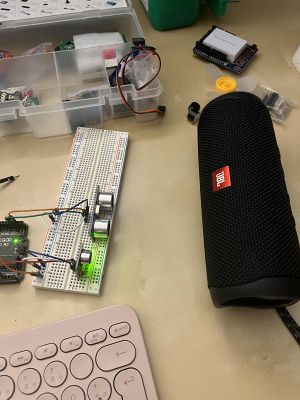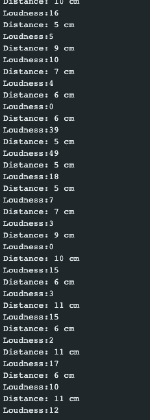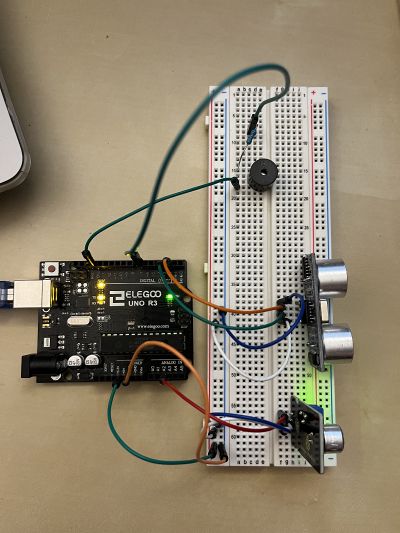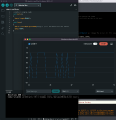GMU:Designing Utopias: Theory and Practice/Selena Deger: Difference between revisions
| Line 1: | Line 1: | ||
''07.12.22'' | ''07.12.22'' | ||
=='''Analog sound | =='''Analog sound and ultrasonic distance sensor'''== | ||
https://wiki.keyestudio.com/KS0035_Microphone_Sound_Sensor_with_Potentiometer | https://wiki.keyestudio.com/KS0035_Microphone_Sound_Sensor_with_Potentiometer | ||
| Line 10: | Line 10: | ||
Ultrasound distance sensor consists of a trigger and receiver parts, one is releasing ultrasonic waves and the other is receiving the reflected waves to calculate the distance from the duration of the bouncing time. The detection range is 2-40cm. | Ultrasound distance sensor consists of a trigger and receiver parts, one is releasing ultrasonic waves and the other is receiving the reflected waves to calculate the distance from the duration of the bouncing time. The detection range is 2-40cm. | ||
'''connecting to Arduino''' | '''connecting to Arduino''' | ||
| Line 17: | Line 18: | ||
To see the differences in the values, I put some track on the bluetooth speaker and moved it in front of the distance sensor. | To see the differences in the values, I put some track on the bluetooth speaker and moved it in front of the distance sensor. | ||
[[File:sd_jbl.jpg| | [[File:sd_jbl.jpg|300px]] | ||
[[File:sel_loud.png| | [[File:sel_loud.png|150px]] | ||
[[:File:sel_sound.mp4]] | |||
<source style="border:none; height:300; overflow:scroll;" lang="c" line start="55" highlight="4"> | |||
#define echoPin 2 // attach pin D2 Arduino to pin Echo of HC-SR04 | |||
#define trigPin 3 //attach pin D3 Arduino to pin Trig of HC-SR04 | |||
int buzzer = 7; | |||
// defines variables | |||
long duration; // variable for the duration of sound wave travel | |||
int distance; // variable for the distance measurement | |||
void setup() { | |||
// put your setup code here, to run once: | |||
pinMode(trigPin, OUTPUT); // Sets the trigPin as an OUTPUT | |||
pinMode(echoPin, INPUT); // Sets the echoPin as an INPUT | |||
Serial.begin(9600); | |||
} | |||
void loop() { | |||
int val; | |||
val=analogRead(2); | |||
Serial.print("Loudness:"); | |||
Serial.println(val,DEC); | |||
delay(100); | |||
// Clears the trigPin condition | |||
digitalWrite(trigPin, LOW); | |||
delayMicroseconds(2); | |||
// Sets the trigPin HIGH (ACTIVE) for 10 microseconds | |||
digitalWrite(trigPin, HIGH); | |||
delayMicroseconds(10); | |||
digitalWrite(trigPin, LOW); | |||
// Reads the echoPin, returns the sound wave travel time in microseconds | |||
duration = pulseIn(echoPin, HIGH); | |||
// Calculating the distance | |||
distance = duration * 0.034 / 2; // Speed of sound wave divided by 2 (go and back) | |||
Serial.print("Distance: "); | |||
Serial.print(distance); | |||
Serial.println(" cm"); | |||
</source> | |||
| Line 30: | Line 81: | ||
added the code a condition about the distance. When the distance is smaller than 10cm, buzzer starts to buzz with the mapped values also from the sound and distance sensor. | added the code a condition about the distance. When the distance is smaller than 10cm, buzzer starts to buzz with the mapped values also from the sound and distance sensor. | ||
<source style="border:none; height:auto; overflow:scroll;" lang="c" line start="55" highlight="4"> | |||
if(distance<10) { | |||
long buzz = map(val, 0, 40, 1000, 5000); | |||
long del = map(distance, 2, 40, 100, 800); | |||
tone(buzzer, buzz); | |||
// tone() is the main function to use with a buzzer, it takes 2 or 3 parameters (buzzer pin, sound frequency, duration) | |||
delay(del); | |||
} | |||
else { | |||
tone(buzzer, 0); | |||
} | |||
</source> | |||
[[:File:sel_buzzer.mp4]] | |||
Revision as of 22:11, 7 December 2022
07.12.22
Analog sound and ultrasonic distance sensor
https://wiki.keyestudio.com/KS0035_Microphone_Sound_Sensor_with_Potentiometer
Analog sound sensor includes a microphone sensor to detect ambient sounds and loudness of them. In some sources usage is recommended with an audio analyzer module(https://www.dfrobot.com/product-514.html) to differentiate different frequencies.
https://www.sparkfun.com/products/15569
Ultrasound distance sensor consists of a trigger and receiver parts, one is releasing ultrasonic waves and the other is receiving the reflected waves to calculate the distance from the duration of the bouncing time. The detection range is 2-40cm.
connecting to Arduino
Analogue sound is connected to the analog pin, while trigger and receiver pins of the ultrasound sensor are connected to two different digital pins.
To see the differences in the values, I put some track on the bluetooth speaker and moved it in front of the distance sensor.
#define echoPin 2 // attach pin D2 Arduino to pin Echo of HC-SR04
#define trigPin 3 //attach pin D3 Arduino to pin Trig of HC-SR04
int buzzer = 7;
// defines variables
long duration; // variable for the duration of sound wave travel
int distance; // variable for the distance measurement
void setup() {
// put your setup code here, to run once:
pinMode(trigPin, OUTPUT); // Sets the trigPin as an OUTPUT
pinMode(echoPin, INPUT); // Sets the echoPin as an INPUT
Serial.begin(9600);
}
void loop() {
int val;
val=analogRead(2);
Serial.print("Loudness:");
Serial.println(val,DEC);
delay(100);
// Clears the trigPin condition
digitalWrite(trigPin, LOW);
delayMicroseconds(2);
// Sets the trigPin HIGH (ACTIVE) for 10 microseconds
digitalWrite(trigPin, HIGH);
delayMicroseconds(10);
digitalWrite(trigPin, LOW);
// Reads the echoPin, returns the sound wave travel time in microseconds
duration = pulseIn(echoPin, HIGH);
// Calculating the distance
distance = duration * 0.034 / 2; // Speed of sound wave divided by 2 (go and back)
Serial.print("Distance: ");
Serial.print(distance);
Serial.println(" cm");
creating the loop
I have added a piezzo buzzer (+ 1K resistor) to the circuit to make the process of loudness detection more cyclical. I have followed this tutorial connecting it > https://surtrtech.com/2018/01/29/how-to-use-a-buzzer-piezo-speaker-with-arduino/
added the code a condition about the distance. When the distance is smaller than 10cm, buzzer starts to buzz with the mapped values also from the sound and distance sensor.
if(distance<10) {
long buzz = map(val, 0, 40, 1000, 5000);
long del = map(distance, 2, 40, 100, 800);
tone(buzzer, buzz);
// tone() is the main function to use with a buzzer, it takes 2 or 3 parameters (buzzer pin, sound frequency, duration)
delay(del);
}
else {
tone(buzzer, 0);
}
01.12.22
line tracking sensor
https://wiki.keyestudio.com/Ks0050_keyestudio_Line_Tracking_Sensor
Line tracking sensor is used for differentiating between black and white(either can be the backgorund/foreground) with the integrated infrared sensors(one emitting, one collecting). It is very dependent on the reflectiveness of the material/object therefore it is important to have a consistent and equal light source on the surface.
connecting to arduino
After following the instructions in the producer website, I have managed to get the first digital outputs from the sensor.
To get different numbers from the sensor(other than hi/lo), I connected it to an analog input.
void setup()
{
Serial.begin(9600);
}
void loop()
{
Serial.println(analogRead(A0)); // print the data from the sensor
delay(500);
}
moving data to processing
Following this tutorial > https://www.arduino.cc/education/visualization-with-arduino-and-processing I have first uploaded this code snippet to the arduino
unsigned int ADCValue;
void setup(){
Serial.begin(9600);
}
void loop(){
int val = analogRead(0);
val = map(val, 0, 300, 0, 255);
Serial.println(val);
delay(50);
}Lastly running different examples from the same tutorial on processing, resulted in different visualization of the black/white data retrieved from the sensor.








